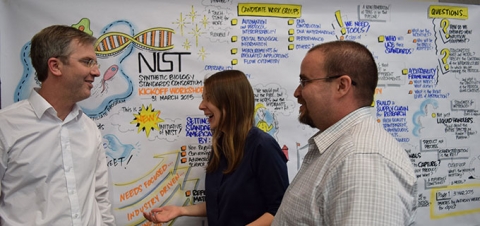May202016
Posted at 2:38 PM

Guest post by Laurie Locascio, PhD, Director of the Material Measurement Laboratory at National Institute of Standards and Technology (NIST)
This year’s World Metrology Day is themed “Measurements in a Dynamic World,” so it’s fitting that we are also celebrating the formal launch of the NIST-Stanford Joint Initiative for Metrology in Biology, or JIMB. The initiative began as a pilot three years ago to answer the biotech industry’s calls for measurement tools.
The biotechnology industry is blooming. The ability to cheaply and efficiently sequence the genomes of everything from bacteria to humans has revolutionized our understanding of biological systems. Scientists in labs the world over are manipulating genomes to make simple organisms into factories that produce better therapeutics, fuels and food; clean up oil spills; and enrich depleted soils for sustainable agriculture. Algae can be made into biofuels and coaxed to make ethylene for the production of plastics. Bacteria can be programmed to monitor water and air for pollutants or fight crop diseases and pests.
Patients benefit, too: Protein drugs made by living cell lines are often more effective than their traditional counterparts, and new cancer treatments made of engineered cells prompt a patient’s own immune system to attack tumors and have fewer side effects that other therapies.
Biotechnology generated at least $324 billion in revenue in 2012 in the U.S. alone, with revenues increasing each year much faster than the total economy. While there is clearly a marketplace for all that biology has to offer, its living cells and systems are hard to measure. That makes it difficult to achieve reliable mass production like we see in the manufacture of goods made of less dynamic materials like plastic and metal. The steering wheel in your car, for example, can be reliably reproduced by any number of factories around the world if given the correct specifications with exact measurements. That is not yet the case for many biological products.
NIST is changing that by working with the biotech industry to develop quantitative measures, along with standards and methods for the whole field to use, that will help turn advances in the biological sciences into replicable products. Our partnership at JIMB combines NIST’s metrology expertise and reputation as an unbiased broker with Stanford’s prowess in biology. Stanford’s strong relationships with area biotechnology companies will continue to inform JIMB’s work so that it is as widely applicable as possible. In addition to enhancing production, measurements are also critical if a product is subject to regulatory oversight, so that manufacturers and regulators alike have confidence in the information that guides decisions.
Today, we celebrate the formal launch of JIMB by welcoming new collaborators, the awardees of seed grants for the development of measurement science both in the basic realm, and that can be transferred to industry for their application. They join the 16 NIST staff located at JIMB, including NIST postdoctoral researchers embedded in Stanford faculty members’ labs and eight Stanford graduate students supported by a NIST grant — where they can leverage NIST metrology expertise with Stanford’s impressive capabilities in biological engineering.
Let’s look back in another three years to see how far JIMB and biotechnology revenues have come. We will see a robust bioeconomy driven by innovative products that treat illness and help us resist disease, increase crop yields while protecting the environment, identify and remediate pollutants, and fuel transportation without contributing new carbon to the atmosphere.
I know we’ll be amazed.
